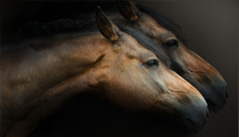
|
|
Equine chiropractic care
When a chiropractor or veterinarian, professionally trained in animal chiropractic, identifies a subluxation, he or she aims to correct the misalignment of the spine and restore mobility to the facet joints.
Realignment is made via a quick, short thrust along the plane of the joint. This is called an adjustment. The adjustment is a very specific, high speed, low force manoeuvre that moves the affected joint beyond the normal physiologicalarticular range of movement, without exceeding the boundaries of anatomical integrity. It is done by placing the hands directly on the affected vertebra (previously identified in the examination). Only subluxated vertebrae are adjusted.
Even though horses have a very large, thick muscle mass over the spine, the vertebral joints are flexible and relatively easy to manipulate with minimal force. If the correct technique is used the ligaments are not adversely affected.
“Straightening” the spine by pulling on the legs or tail is “non specific” as it affects a number of joints before reaching the vertebra (i.e. when using the leg as a lever the fetlock, hock, stifle and hip joints will all be affected).
Non-specific techniques if not done properly, can damage the ligaments and joints, so it is important to avoid unspecific procedures in favour of safe methods of treatment.
A complete chiropractic treatment also includes the examination (and if necessary treatment) of limb joints and temporomandibular joint.
One question often asked of chiropractors is “How many treatments will the horse require?” This question must be answered on an individual basis for each patient. In most cases, a single treatment is not enough to eliminate the problem.
The goal of chiropractic treatment is to address neurological dysfunction in the spine and restore mobility. It is then the task of muscles and ligaments to support the spine and maintain this new realigned position.
This process and the role of the chiropractor is similar to that of an orthodontist. The orthodontist applies braces to the teeth and over a period of time makes regular adjustments and corrections to realign the teeth, so that in time they will maintain their correct position. A chiropractor adjusts the spine to restore normal motion in the joint. This may need to be done a number of times, until the body accepts the normal motion and the muscles and ligaments support and maintain that motion.
Most horses show significant improvement after one to four treatments. Chronic problems usually take longer to resolve requiring more chiropractic treatment, whereas horses with acute problems often respond more quickly.
How to recognize back problems
 Powered by quicksite v 4.6.7© 2002-2019 All rights reserved
Powered by quicksite v 4.6.7© 2002-2019 All rights reserved
